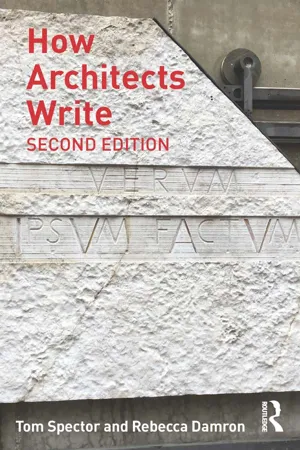
- 270 pages
- English
- ePUB (mobile friendly)
- Available on iOS & Android
eBook - ePub
How Architects Write
About this book
How Architects Write shows you the interdependence of writing and design in both student and professional examples. This fully updated edition features more than 50 color images, a new chapter on online communication, and sections on critical reading, responding to requests for proposals, the design essay, storyboarding, and much more. It also includes resources for how to write history term papers, project descriptions, theses, proposals, research reports, specifications, field reports, client communications, post-occupancy evaluations, and emailed meeting agendas, so that you can navigate your career from school to professional practice.
Frequently asked questions
Yes, you can cancel anytime from the Subscription tab in your account settings on the Perlego website. Your subscription will stay active until the end of your current billing period. Learn how to cancel your subscription.
No, books cannot be downloaded as external files, such as PDFs, for use outside of Perlego. However, you can download books within the Perlego app for offline reading on mobile or tablet. Learn more here.
Perlego offers two plans: Essential and Complete
- Essential is ideal for learners and professionals who enjoy exploring a wide range of subjects. Access the Essential Library with 800,000+ trusted titles and best-sellers across business, personal growth, and the humanities. Includes unlimited reading time and Standard Read Aloud voice.
- Complete: Perfect for advanced learners and researchers needing full, unrestricted access. Unlock 1.4M+ books across hundreds of subjects, including academic and specialized titles. The Complete Plan also includes advanced features like Premium Read Aloud and Research Assistant.
We are an online textbook subscription service, where you can get access to an entire online library for less than the price of a single book per month. With over 1 million books across 1000+ topics, we’ve got you covered! Learn more here.
Look out for the read-aloud symbol on your next book to see if you can listen to it. The read-aloud tool reads text aloud for you, highlighting the text as it is being read. You can pause it, speed it up and slow it down. Learn more here.
Yes! You can use the Perlego app on both iOS or Android devices to read anytime, anywhere — even offline. Perfect for commutes or when you’re on the go.
Please note we cannot support devices running on iOS 13 and Android 7 or earlier. Learn more about using the app.
Please note we cannot support devices running on iOS 13 and Android 7 or earlier. Learn more about using the app.
Yes, you can access How Architects Write by Tom Spector,Rebecca Damron in PDF and/or ePUB format, as well as other popular books in Arquitectura & Arquitectura general. We have over one million books available in our catalogue for you to explore.
Information
one
HOW (AND WHY) ARCHITECTS WRITE
Now if it were asked: “Do you have the thought before finding the expression?” what would one have to reply? And what, to the question: “What did the thought consist in, as it existed before its expression?”1
—Ludwig Wittgenstein, philosopher
Architects often finish their sentences with a sketch.2
—Peter Medway, applied linguist
THE NEED FOR CLEAR WRITING
Clarity. If the objectives of this handbook could be boiled down to a single watchword, this would be it. The objective of writing clearly has so many dimensions—clarity of intent, clarity of expression, clarity of audience—that it can seem an overwhelming task at first. Fortunately, the task becomes less formidable when broken down into its four constituent parts (Figure 1.1): Good writers have sufficient command of their subject matter to convey confidence that they know what they are talking about. Their use of language is both clear and appropriate—they understand the rhetorical standards expected of them. They have a firm grasp on their writing process— not only mastery of the mechanics, grammar, and self-editing emphasized in freshman composition, but also of the steps required to, for example, organize their observations into reports. And they have clarified the expectations of their audience; that is to say, they understand the demands of the genre in which they are writing.

FIGURE 1.1 Writing’s four knowledge types: Writing Process Knowledge, Subject Matter Knowledge, Genre Knowledge and Rhetorical Knowledge
Writing Process Knowledge
Field notes, Feb. 22:
Steel erected to 45th floor
Electrical service entry discussed
Membrane roof installed on building 1
Curtainwall mock-up panel reviewed
Retaining wall stabilized
Elevator shaft wall #2 corrected
Prefabricated steel stairs ordered
Subject Matter Knowledge
Building: Hemispheric
Location: City of Arts and Sciences, Valencia, Spain
Architect: Santiago Calatrava
Date: 1998

Genre Knowledge
Evolution of High-Tech:
1.Early Milestones
a.Pompidou Center
b.James Stirling’s buildings in the UK
2.High-Tech goes mainstream
a.Norman Foster
Rhetorical Knowledge
Daniel Libeskind’s Jewish Museum in Berlin seeks to convey emotions of horror and moral outrage to the Holocaust in a museum experience. …
By mastering the elements of clear architectural writing— gaining command over the subject matter, employing appropriate rhetorical standards, establishing efficient processes, and understanding the demands of the different writing genres—students and practitioners will not only become better writers but will also make themselves better architects.
When the role of writing in architectural production was used primarily to explain a design that was already conceived visually, then the written word could be relegated to an ornamental role at the tail-end of a linear process.
Writing happened after all the really interesting work was done. But this conception is long out of date. Writing doesn’t just record what has already been done; it is part of the doing. What linguist Peter Medway discovered by observing both architectural practitioners and students was the fluidity with which architects must move between the graphic, oral, and written modes when developing and communicating design intent. This is the observation his quote at the beginning of the chapter is meant to convey. After observing architects at work in a number of different situations, he offers, “We are surprised and impressed by the linguistic virtuosity called for in the job.”3 Yes, sentences do end in sketches, but by the same token, sketches are illuminated by sentences. The design moves forward, not linearly, but iteratively as the designer gropes toward a desired future state of affairs. It gains authority as the mind incorporates information from a variety of sources. If design is allowed to be about more than the creation of geometric form, then a fluid conception that places design at the center of an activity informed by graphic, oral, and written modes is a more adequate representation.
If the linear conception of writing’s role in architecture was ever adequate, it certainly is not now. Both the increasingly collaborative environment of the construction economy, as well as technological advances in the design process, have placed a premium on architects’ ability to write to be effective on the job. Whereas at one time, architects might have conceived of themselves as visual artists handing off their designs for others to figure out how to build, today they are more likely to be at the center of an integrated team needing someone to organize its intense communication needs. These days, the value of one’s investments may fade, but emails are forever. Litigation—and preventing it—is heavily dependent on crisp, clear writing. However, it is important to remember that effective writing is not only business-oriented. No one achieves stature in the profession without at least one monograph explaining the firm’s design thinking. Press and criticism are as important as ever for building a critical reputation. Meanwhile, the explosion of information that can now be brought to bear on a building design means that someone must be able to manage and organize it, and the logical center of the design process resides with the persons charged with bringing the diverse sources of information together. To exploit the opportunities that the information age presents, architects must be able to write well, edit, and integrate the information generated by others into a coherent whole. The concept of the architect as Master Builder is disappearing, transforming into that of the architect as Master of Information. This new role is not a demotion, but it does signify a shift in how the world is pressing architects to think about design. In this emerging model, the design itself is usefully understood as either existing suspended at the center of a web of diverse information, or else as being the sum of all the information that comes to bear on it. Architectural form emerges out of—and becomes part of—the sea of relevant information, which includes the written word. Taken together, these developments make the need for achieving clarity in one’s writing all the more urgent, and central.

FIGURE 1.2 Writing’s Role in the Linear View: A design is conceived in models, drawings, and sketches; It is presented with advanced graphics and oral explanation; Instructions are communicated via 2D graphics and writing.
FOUR TYPES OF WRITING KNOWLEDGE: SUBJECT MATTER KNOWLEDGE, RHETORICAL KNOWLEDGE, PROCESS KNOWLEDGE, AND GENRE KNOWLEDGE
Think of the four aspects of clear writing as four different types of knowledge. Where and how are they transmitted? As it turns out, the majority must come from within one’s chosen discipline and cannot be subcontracted out to the English department with any expectation of success. Most of the work students do to improve their writing will necessarily come from within the architecture school curriculum. This is why the chapters in this book are organized around the typical writing tasks encountered as one progresses through school.
Subject Matter Knowledge
It is easy to see how one would be unable to think, much less write, perceptively within the field of architecture in the absence of such discipline-specific subject matter knowledge as architecture history, construction technology, and contractual relationships. By analyzing a fifth-year undergraduate student’s architectural design thesis, Medway saw the process of a student’s move into “architectural thinking” through a trajectory that included alternations of drawing and writing, a process that resulted in writing functioning as a design tool.4 In doing so, he demonstrated that students can never fully compensate for a spotty architecture vocabulary with, say, formal virtuosity because subject matter knowledge is so fundamental. Much of the writing done in architecture school is to demonstrate that one has assimilated and can synthesize subject matter information into one’s observations (Chapters 2 and 6) and one’s understanding of history (Chapters 3 and 8, especially).

FIGURE 1.3 Subject Matter Knowledge.
Rhetorical Knowledge
Some rhetorical knowledge does apply across disciplines, but only the most basic rhetorical elements of argumentation and logic can be effectively installed by outsiders. To see why this is so, consider Medway’s contention that design itself is rhetorical in nature and, thus, schools of architecture teach students how to argue. This argumentative education is not only learned through the oral elements of crits or reviews, but also in the process of design itself. “Buildings that lack a ‘proposition’ or idea … are ineffective (as is criticism that evades these issues).”5 He also sees broader implications for understanding the role of rhetoric in architecture: The propositional content of design is a crucial element enabling students to make rational and reasonable decisions as their designs progress. Students who are unable to adequately theme a...
Table of contents
- Cover
- Half Title
- Title Page
- Copyright Page
- Table of Contents
- Acknowledgments
- Image Credits
- 1 How (and why) Architects Write
- 2 Design Journals
- 3 History Term Papers
- 4 Project Descriptions
- 5 Writing for Your Online Presence
- 6 Research Reports and Analyses
- 7 Business Documents
- 8 Statements of Design Philosophy, Essays, and Manifestos
- 9 Thesis and Dissertation Writing
- Index